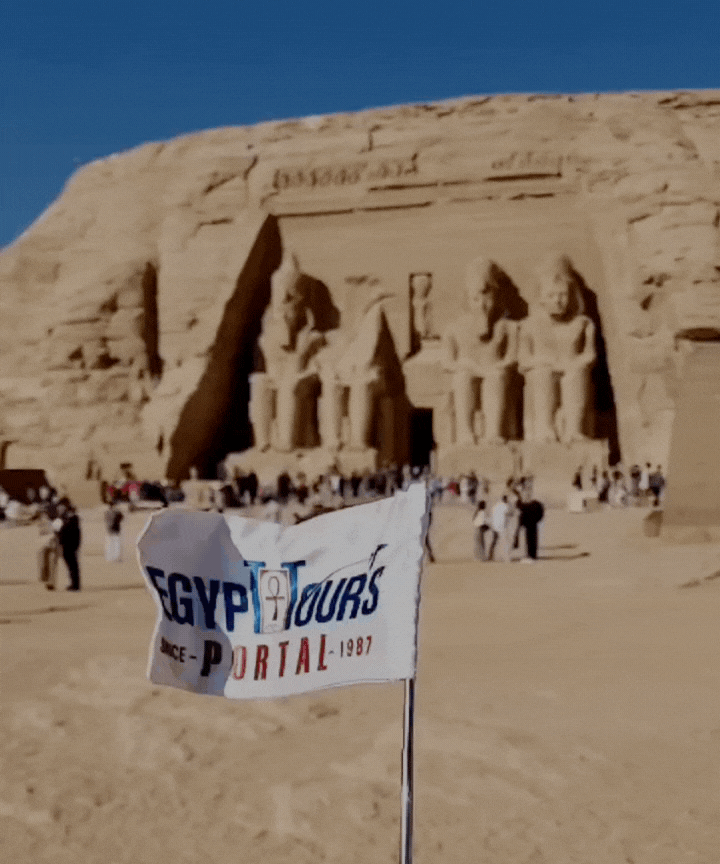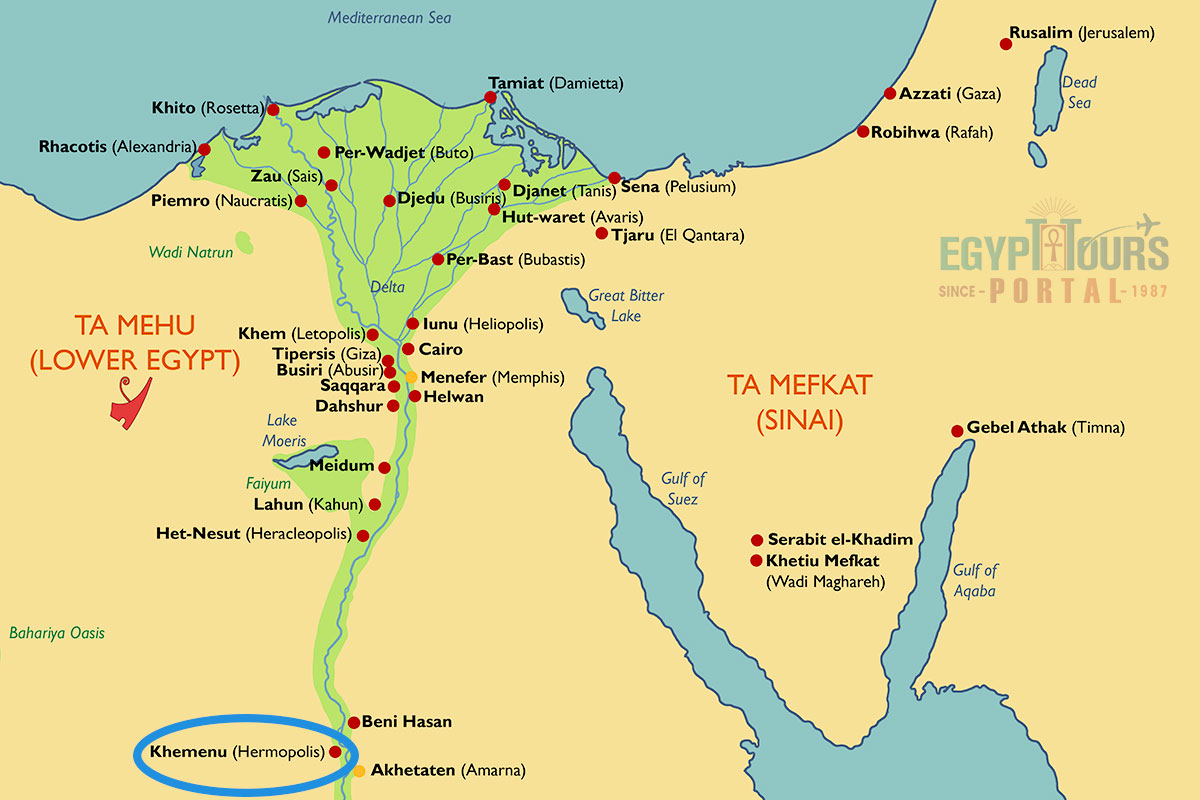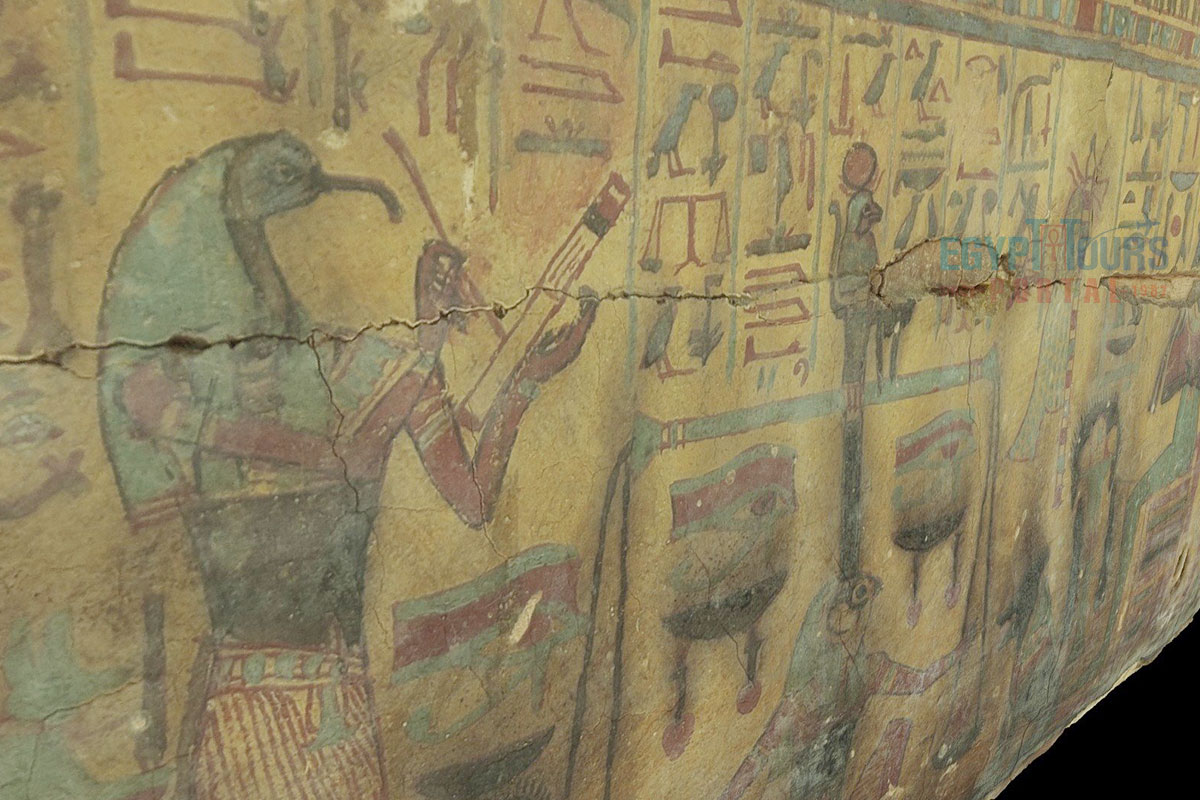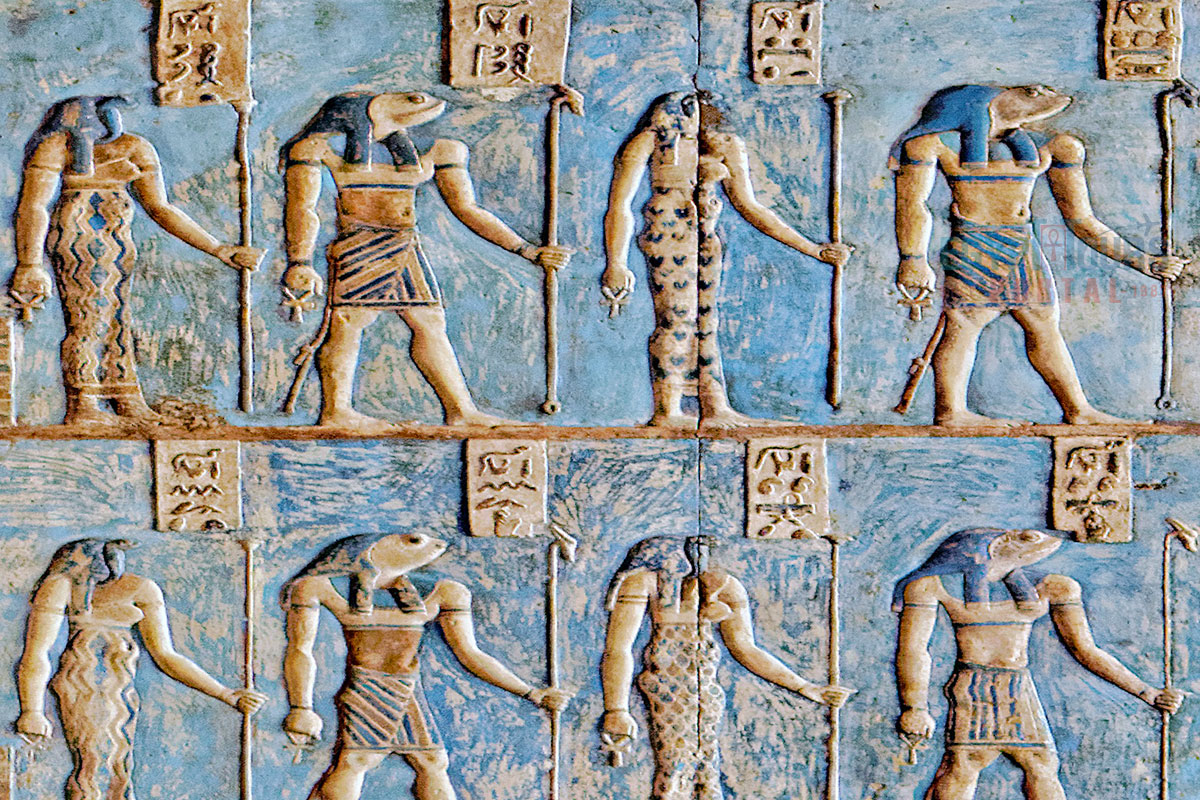Hermopolis (El Ashmunein) is an ancient city in Middle Egypt with religious, cultural, and administrative importance from the Old Kingdom to the Greco-Roman era. It was dedicated to Thoth, the god of wisdom and writing, and was the birthplace of the Ogdoad creation myth. The city featured monumental structures like the Temple of Thoth, decorated with statues, inscriptions, and stelae. In the Christian era, it became an early Coptic center, marked by a 5th-century basilica. Excavations revealed mudbrick houses, cemeteries, altars, and royal cartouches from pharaohs such as Akhenaten and Nectanebo II. Hermopolis reflects a fusion of Egyptian, Hellenistic, and Christian traditions, preserving its legacy as a symbol of myth, spirituality, and artistry.


Hermopolis, also known as Al Ashmunin is the celestial embodiment of the ancient Egyptian mythology that cultivated the culture of the ancient Egyptian and gave rise to this immortal joyous city that can captivate many archaeologists, historians, and enthusiasts from all over the world with an ethereal eco of enriching and enchanting tales of wonder and magic.
Thousands of years ago, Hermopolis emerged as a key player at the confluence of Upper and Lower Egypt, celebrated for its administrative importance, strategic position, and religious devotion to the deities Typhon and Thoth. This lesser-known marvel has a deeply blessed nature as it was crafted by angelic powers and godly cosmic powers that have been a center of worship for thousands of years.
In this magnificent spot is a rich tapestry of myths, beliefs, artistic and architectural wonders that inspire to narrating of some highly thrilling stories that can be found carved across the stars. This phenomenal creation will get to break the boundaries of time, touch the timeless soul of this radiating wonder, discover the heritage of this glorious location, and get a divine glimpse of the full glory of ancient Egyptian civilization.

Hermopolis is situated near the modern town of El Ashmunein, along the western bank of the Nile River. To reach this storied destination, travelers can embark on a journey from Cairo, a city steeped in its ancient history. The route to Hermopolis unveils Egypt's timeless landscapes and can be traversed by road or the scenic Nile waters, offering a glimpse into the nation's historical tapestry.
Witness all the magical ancient cities of Egypt that stood the test of time
Read More
The ancient city, known in the Egyptian language as Khemenu (Ḫmnw) or Khmun, carries a meaningful designation, "Eight-Town or Town of Eight" referring to the revered Ogdoad, a collective of eight "primordial" deities whose worship was centered there. This distinctive name has endured through time, evolving into Coptic as Ϣⲙⲟⲩⲛ Shmun, and further transforming into the contemporary appellation, el Ashmunein in Arabic.
In the realm of Koine Greek, this city assumed the title "The City of Hermes," a reflection of the Greeks' identification of Hermes with Thoth. This association stemmed from the city's pivotal role as the primary center of worship for Thoth, the esteemed Pharaonic deity revered for magic, healing, wisdom, and the patronage of scribes. Interestingly, Thoth shared a similar connection with the Phoenician divine figure, Eshmun. Inscriptions within the temple refer to Thoth as "The Lord of Eshmun," underscoring this intricate linkage.
Learn about the great gods and goddesses of ancient Egypt that influenced the culture of the ancient cities
Read More
Hermopolis used to be distinguished as the capital of the Hare nome, the fifteenth nome of Upper Egypt, situated within the Heptanomis region since the early days of the Old Kingdom. Throughout history, the territorial extent of the Thebaid, the upper region, reached further north than it does in more recent times, with Hermopolis strategically situated as a prominent border town between these two regions.
This pivotal location bestowed upon Hermopolis a remarkable prominence and affluence, positioning it as an esteemed hub of resort and opulence, second only to Thebes itself. A short distance to the city's south, one would find the Hermopolis Castle, where rivercraft voyaging from the Thebaid contributed tolls at this crucial juncture. This site, known as Ἑρμοπολιτάνη φυλακή in Greek and the Bahr Yussef in Arabic, played a crucial role in the bustling trade and movement along the river.
Interestingly, the grottos of Beni Hasan, located near Antinoöpolis on the opposite bank of the Nile, served as the shared resting place for the Hermopolitans in death. Despite the river's division between the city and its necropolis, the curvature of the western hills made it more practical to ferry the deceased across the water rather than navigating the challenging terrain by land.
During the Roman era, Hermopolis flourished as a significant urban center within the province of Thebais Prima, under the jurisdiction of the administrative diocese of Egypt. Central to the religious fabric of Hermopolis were its principal Egyptian deities: Typhon (Set) and Thoth. Typhon's representation took the form of a hippopotamus, atop which perched a hawk engaged in combat with a serpent. Thoth, closely associated by the ancient Greeks with Hermes due to their shared dominion over magic and writing, found his embodiment in the ibis.

The city of Hermopolis was heavily associated with the Christian tradition as a refuge for the Holy Family during their exile in Egypt. It was a suffragan diocese of the Metropolitan Archdiocese of Antinoe within the Patriarchate of Alexandria. However, the city's prominence diminished over time, particularly under Islamic influence.
The city's list of bishops includes notable figures from various periods, such as Conon around 250 AD, Fasileus in 325 AD, Dios around 350 AD, and others up to the 7th century. Hermopolis Maior held a titular diocese status in the Roman Catholic Church and remains as such in the Coptic Orthodox Church. In the 18th century, the diocese was nominally revived as the Latin Titular bishopric of Hermopolis Maior, later renamed Hermopolis Magna in 1925-1929.
The titular see had several incumbents, holding the rank of Episcopal, with responsibilities in different parts of the world. Notable individuals include Luigi Antonio Valdina Cremona, Dominik Józef Kiełczewski, and Antoni Melchior Fijałkowski, among others. Despite its historical and ecclesiastical significance, the titular see of Hermopolis Maior was suppressed in 1949, bringing an end to its formal representation within the church hierarchy.

The attraction has a lot of deep religious significance, which is rooted in the mythological belief systems of the ancient Egyptians that depended on many gods and tales. It acted as a provincial capital during the Old Kingdom, a major city during the Roman Empire, and a 3rd-century center of early Christianity. The place was then abandoned after the muslim conquest around 640, then later on restored as a latin catholic, then Coptic Orthodox. It is famous in ancient Egypt as a powerful religious center where the worship of Thoth and the Ogdoad took place.
The Ogdoad were eight primeval deities made of four frog-gods and four snake-goddeses who were associated with the Hermopolitan creation myth and were the embodiment of the four aspects of chaos, on the other hand, Thoth who was the patron deity of the city who was revered as a scribe of the gods, the inventor of writing, and the judge of the dead. He was also associated with the moon and time-keeping, making him a multifaceted deity with significant influence over various aspects of ancient Egyptian life.
He can be seen across the site in the shape of incredible, colossal baboon statues. The priests of Hermopolis held an important role in Egyptian religious practices, including performing rituals, maintaining sacred texts, and preserving the city's traditions. The city was filled with countless temples, shrines, and other religious structures dedicated to these religious deities.
Explore more magnificent details about the rituals, beliefs, and customs of the religion of the ancient Egyptians.
Read More
Hermopolis was renowned for its creativity, philosophy, and enlightenment, and gave rise to the Hermetic philosophical work known as Hermetica. This philosophical writing held profound wisdom and was centered around the elusive "Book of Thoth," which was once considered a myth but has been substantiated by recent discoveries of fragments.
The book is believed to underpin the foundations of hermetic philosophy and is said to contain the world's wisdom. Legends speak of the Book of Thoth being situated at the far reaches of this city, hidden within a series of protective containers like a Russian doll; first a tin box, then a copper box, followed by silver, and finally gold. Safeguarding this ancient knowledge is a serpent, revered and left unharmed by those seeking the book.

The Hermopolis creation myth was also known as the Ogdoadic myth, which was a very famous and epic ancient Egyptian creation story that originates from the golden city of Hermopolis (modern-day El Ashmunein) that focuses on the primordial creation and state of the universe before creation and the emergence of the cosmos. This myth is part of several creation stories that were created by different regions and periods within ancient Egypt to explain the rise of the cosmos and its forces.
It can highlight the importance of balance, duality, and the interplay between male and female aspects in the process of creation, and underscores the belief in the power of deities to shape and order the universe from its chaotic beginnings. The myth states that the universe is depicted as a watery, dark void called Nun, representing chaos and formlessness. Within Nun, there exist eight deities arranged in four pairs, known as the Ogdoad. Each pair consists of a male and a female deity, representing the concept of balance and harmony. The four pairs of deities are:
They are symbolized as an aquatic creature that lived in water, as the males were seen as frogs and the females were seen as snakes. According to the Hermopolis creation myth, these primordial deities existed within Nun, and their interactions and unions led to the creation of the universe. The creative forces of these deities brought about the emergence of a pyramidal mound of land or a lotus flower that emerged from the sun, which rose to the sky to light the world. This mound or lotus flower became the point of origin for the rest of creation, and then came Atum to lead to the creation of balance and order by creating all the other deities and humanity.

The design of the city acts as an open museum filled with many ruins and pieces of art that come in the shape of great columns, shrines, statues, colossi, stelaes, crumbling mud bricks, destroyed stone temples, and more. The entire area acts as an open-air museum filled with very meaningful monuments that reveal several great facts and tales from many periods across the vast history of Egypt. The most famous attractions within its layout include:
Hermopolis, a town that managed to avoid the ravages of frequent wars during the decline of the Pharaonic and Roman periods, still underwent significant transformations under its Muslim rulers. These rulers used their structures for lime or building materials. A surviving document from the 3rd century AD reveals the existence of impressive seven-story buildings in the town. Numerous Arabic papyri from the 2nd to 4th centuries AH found in the John Rylands Library, Manchester, refer to Hermopolis.
The Temple of Thoth was originally constructed during the reign of Necatnebo I in Dynasty XXX, boasts impressive remnants. Necatnebo I rebuilt sections and encased the temple precinct within substantial mudbrick walls, 15 meters deep. The temple complex includes notable features like Nectanebo's gateway, Rameses II's pylon, and a procession route. A preceding structure held Nectanebo's artifacts, including obelisks, royal statues, stelae, and sphinxes.
Alexander the Great expanded the temple during the Late Period by adding a splendid portico with twelve limestone columns adorned with vibrant decorations, designed by Phillip Arrhidaeus and Ptolemy I. Sadly, the portico was lost in 1826, dismantled for a sugar factory, and only column foundations remain. Adjacent to the Temple of Thoth stands an east-facing limestone sanctuary of Amun, safeguarded by a fortified wall from Rameses II's era, embellished with reliefs of Merenptah and Seti II from Dynasty XIX.
While the entrance pylon and parts of the hypostyle hall endure, the rear is submerged. Near the Amun temple, a grand gateway, potentially the original entrance to the Temple of Thoth, dates back to the late Middle Kingdom under Amenemhet II. This structure's façade and passage still partially survive. Further south, a small temple erected in Rameses II's reign, later augmented by Nero, featured two seated colossi of Rameses at the entrance. On the village outskirts, fragmentary remains of a temple dedicated to Nehemetaway, Thoth's spouse, built during Emperor Domitian's time, mark the latest addition to Hermopolis' temples.
The temple of Hermopolis was adorned with sculptures of Thoth, the Ibis-headed god, alongside his symbols: the Ibis and the Cynocephalus monkey. The temple's great portico, a relic from the Pharaonic era, showcased the grandeur of the Ptolemaic additions that, while Greek in origin, were distinctly Egyptian in design and execution. The portico featured a double row of six pillars each, adorned with vibrant colors. The columns displayed a unique construction style, resembling bunches of reeds held together by horizontal bonds. The largest column had a circumference of about 281⁄2 feet and was around 40 feet tall.
Among the remains of Hermopolis, numerous Roman pillars stand as a testament to its historical significance. The Basilica, a cathedral constructed in the 5th century A.D., occupies the site of a former Roman temple dating back to Ptolemy the Third in 300 B.C. The locale is also referred to as the "Agora," signifying the Greek marketplace. Vestiges of a Greek water system, employing pipes for water distribution to residences, harken back to an earlier era. Additionally, nearby lie the ruins of temples attributed to Ramses the Second and Siti the First.
This basilica, measuring 55 meters in length, boasted a colonnaded transept with exedras and side galleries. The nave with an apse was 14.7 meters wide, while the aisles measured 5.6 meters in width. Discovered in 1942 and subsequently documented by various expeditions, this basilica remains one of the most impressive Coptic structures. The city has an honorable museum that contains magnificent artifacts discovered and excavated from the city.

The British Museum excavation team uncovered significant aspects of Hermopolis, Notably, they found well-constructed mudbrick houses from the Third Intermediate Period on the western side, implying affluence among its inhabitants. These houses were attributed to wealthier families, revealing three construction levels. In the Graeco-Roman part, they revealed the 'Dromos of Hermes,' a processional street mentioned in texts, containing reused stones.
An alabaster altar with Amenhotep III's inscriptions was also found. The Graeco-Roman area was built over earlier destroyed structures from the New Kingdom and Third Intermediate Period. Notable findings from the Third Intermediate Period included over 300 fragments of an alabaster stela linked to Osorkon III, describing land and property donations. The team also discovered an ancient Middle Kingdom cemetery enclosed by a massive mudbrick wall. It had vaulted chambers and superimposed graves. Though poorly preserved, numerous pottery jars were found as customary offerings. A later cemetery at Tuna el-Gebel added insights into burial practices.
These excavations unveiled artifacts and structures shedding light on ancient Egyptian life, including the inscription of Nectanebo II dating from 360 to 342 BC. Repurposed stone blocks adorned with Akhenaten's cartouches found new use in constructing the basilica. Remnants of ancient architecture in Egypt that originated during the Hellenistic and Roman epochs. A wealth of minor discoveries, encompassing coins, terracotta figurines, and oil lamps. Numerous small-scale artifacts were uncovered, including coins, figurines made of terracotta, and oil lamps. A dated inscription honoring Thenon, a gymnasiarch of unknown origin from Hermopolis, preserved from the 2nd century BC.
Hermopolis, the venerable Al Ashmunin, stands as a golden example to humanity's ceaseless quest for understanding and connection with the divine and the harsh desert of Egypt. Its mystical aura, profound religious significance, and architectural splendor invite every traveler to embark on a journey through time, to a realm where gods and mortals converged, leaving behind an enduring legacy that continues to captivate and inspire.
As we tread in the footsteps of ancient pilgrims and scholars, we uncover the layers of Hermopolis' story, revealing a fragment of Egypt's eternal soul. So uncover all that you can and witness the everlasting bliss of Hermopolis. Every single moment spent during our Egypt vacations and on board our marvelous Nile river cruise will be the key to exploring all the golden ancient cities of this golden civilization that narrate some of the most incredible tales.
Private 4 Days Cairo Tour Packages for American Travelers 4 days Cairo Egypt Tour pa...
Tour Location: Cairo – Giza...
5 Days Cairo and Alexandria Tour Package For American Travelers 5 days Cairo and Ale...
Tour Location: Cairo/Giza/Alexandria...
6 Days Cairo, Luxor & Aswan Tour Package For American Travelers 6 days Cairo, Lu...
Tour Location: Cairo/Giza/Aswan/Luxor...
Amazing 7 Days Cairo and Hurghada Holiday for American Travelers 7 Days Cairo & ...
Tour Location: Cairo – Giza – Hurgh...
The entire country of Egypt deserve to be explored with its every heavenly detail but there are places that must be seen before any other such as the breathtaking Hurghada's red sea, The wonders of Cairo the pyramids of Giza, the great sphinx, the Egyptian Museum, Khan El Khalili Bazaar, the wonders of Luxor like Valley of the Kings, Karnak & Hatshepsut temple and the wonders of Aswan such as Abu Simbel temples, Philea temple, Unfinished obelisk and The Wonders of Alexandria like Qaitbat Citadel, Pompey's Pillar and Alexandria Library. Read more about the best places to visit in Egypt.
If you want to apply for a Visa On Arrival that lasts for 30 days then you should be one of the eligible countries, have a valid passport with at least 6 months remaining and pay 25$ USD in cash, as for the E-Visa for 30 day you should have a valid passport for at least 8 months, complete the online application, pay the e-visa fee then print the e-visa to later be presented to the airport border guard. You could also be one of the lucky ones who can obtain a free visa for 90 days. Read more about Egypt travel visa.
Egypt has a variety of delicious cuisines but we recommend “Ful & Ta’meya (Fava Beans and Falafel)”, Mulukhiya, “Koshary”, a traditional Egyptian pasta dish, and Kebab & Kofta, the Egyptian traditional meat dish.
The best time to travel to Egypt is during the winter from September to April as the climate becomes a little tropical accompanied by a magical atmosphere of warm weather with a winter breeze. You will be notified in the week of your trip if the Climate is unsafe and if any changes have been made.
You should pack everything you could ever need in a small bag so you could move easily between your destinations.
We have been creating the finest vacations for more than 20 years around the most majestic destinations in Egypt. Our staff consists of the best operators, guides and drivers who dedicate all of their time & effort to make you have the perfect vacation. All of our tours are customized by Travel, Financial & Time consultants to fit your every possible need during your vacation. It doesn't go without saying that your safety and comfort are our main priority and all of our resources will be directed to provide the finest atmosphere until you return home.
You will feel safe in Egypt as the current atmosphere of the country is quite peaceful after the government took powerful measures like restructuring the entire tourist police to include all the important and tourist attractions in Egypt. Read more about is it safe to travel to Egypt.
Wear whatever feels right and comfortable. It is advised to wear something light and comfortable footwear like a closed-toe shoe to sustain the terrain of Egypt. Put on sun block during your time in Egypt in the summer to protect yourself from the sun.
The best activity is by far boarding a Nile Cruise between Luxor and Aswan or Vise Versa. Witness the beauty of Egypt from a hot balloon or a plane and try all the delicious Egyptian cuisines and drinks plus shopping in old Cairo. Explore the allure and wonders of the red sea in the magical city resorts of Egypt like Hurghada and many more by diving and snorkeling in the marine life or Hurghada. Behold the mesmerizing western desert by a safari trip under the heavenly Egyptian skies.
There are a lot of public holidays in Egypt too many to count either religious or nation, the most important festivals are the holy month of Ramadan which ends with Eid Al Fitr, Christmas and new years eve. Read more about festivals & publich holidays in Egypt.
Egypt is considered to be one of the most liberal Islamic countries but it has become a little bit conservative in the last couple of decades so it is advised to avoid showing your chest, shoulders or legs below the knees.
Arabic is the official language and Most Egyptians, who live in the cities, speak or understand English or at least some English words or phrases. Fewer Egyptians can speak French, Italian, Spanish, and German. Professional tour guides, who work in the tourism sector, are equipped to handle visitors who cannot speak Arabic and they will speak enough English and other languages to fulfill the needs of all our clients.
The fastest way is a car, of course, a taxi. If you are in Cairo ride a white taxi to move faster or you could board the fastest way of transportation in Egypt metro if the roads are in rush hour.
The temperature in Egypt ranges from 37c to 14 c. Summer in Egypt is somehow hot but sometimes it becomes cold at night and winter is cool and mild. The average of low temperatures vary from 9.5 °C in the wintertime to 23 °C in the summertime and the average high temperatures vary from 17 °C in the wintertime to 32 °C in the summertime. The temperature is moderate all along the coasts.
It is the home of everything a traveler might be looking for from amazing historical sites dating to more than 4000 years to enchanting city resorts & beaches. You will live the vacation you deserve as Egypt has everything you could possibly imagine.









